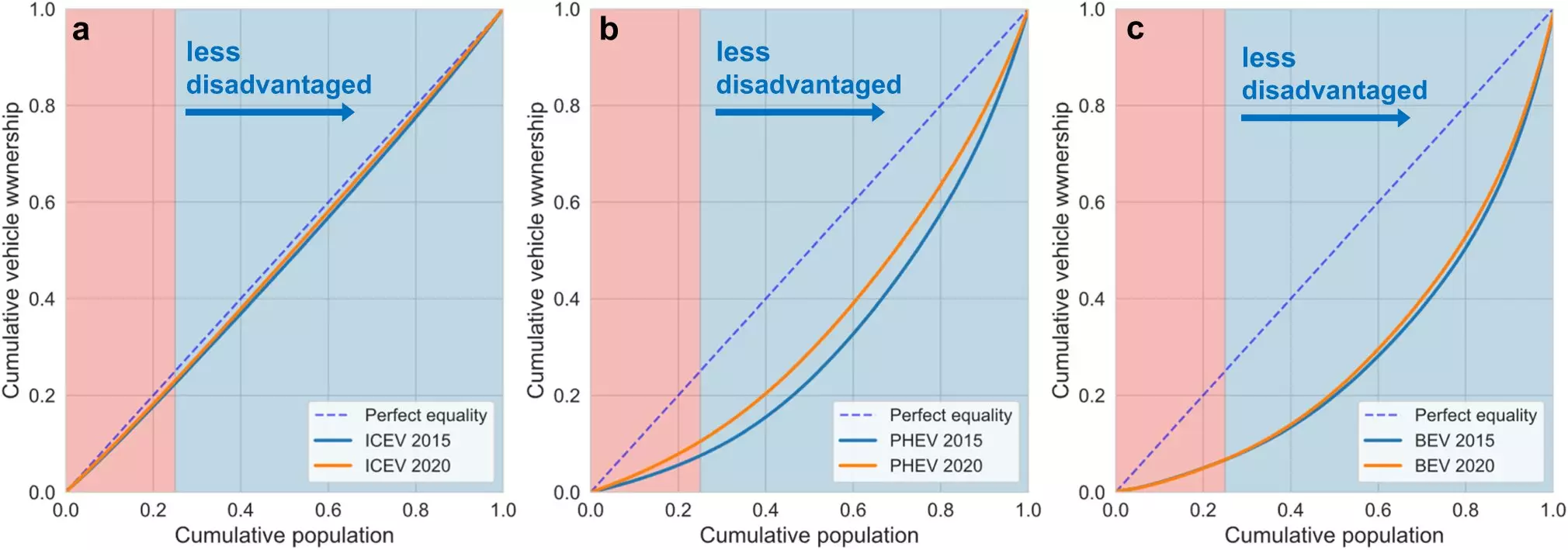Electric vehicles (EVs) have been hailed as a solution to reduce air pollution and improve public health. While it is true that EV ownership is higher in wealthier neighborhoods compared to disadvantaged ones, a new study by UCLA reveals that EVs do have positive effects on air quality across all communities. However, the study also uncovers a concerning reality – the traffic corridors that pass through disadvantaged areas continue to contribute heavily to pollution from gas-powered vehicles. Despite the 40% reduction in pollution experienced by these communities due to widespread EV travel, the large volume of vehicle trips in their vicinity results in significantly higher pollution levels compared to other areas. This revelation highlights the need for a more comprehensive approach to address the unequal impact of air pollution.
The UCLA study, published in the journal Nature Communications, showcases that the benefits of reduced tailpipe emissions from EVs are not limited to the communities where these vehicles are concentrated. Due to the widespread travel patterns of EVs, the positive impact of reduced air pollution is shared across communities. While this finding is encouraging, it also underscores the existence of a significant gap in access to clean air. Disadvantaged communities, despite experiencing some level of pollution reduction, still face disproportionately high pollution levels due to the concentration of all types of vehicles in their neighborhoods. It is clear that there is a need for more comprehensive strategies to bridge this gap and ensure equitable access to clean air for all communities.
To address the disparities in EV ownership and pollution levels, the study recommends the implementation of policies that offer greater financial incentives for lower-income households to purchase zero-emission and electric vehicles. This includes battery-electric, plug-in hybrid, and hydrogen fuel-cell vehicles. Additionally, the researchers advocate for regulations that require medium- and heavy-duty vehicles, such as shipping and delivery trucks, to transition to zero-emission counterparts. Larger vehicles emit more pollution than smaller ones, making this transition crucial in reducing pollution levels in disadvantaged communities. By adopting these policies, it becomes possible to ensure a more equitable distribution of EV benefits and cleaner air for all.
The study highlights the need to actively involve disadvantaged communities in the decision-making process related to the transition to cleaner vehicles. Historically, these communities have had lower EV ownership rates and higher exposure to pollution. To bridge this gap, it is essential to understand the specific barriers that hinder EV adoption in these communities and develop policies that address their unique challenges. Researchers from UCLA are collaborating with community-based organizations to gather firsthand insights into these barriers and involve the affected communities in shaping the solutions. This approach ensures that policies are not only financially inclusive but also adequately address the various non-financial barriers, such as access to charging stations and knowledge about rebates.
The UCLA study employed a sophisticated mobility simulation model to project the effects of EV adoption on air quality and equity in Los Angeles County. By incorporating data on demographics, housing types, commutes, and vehicle use, the researchers were able to assess the impact of different policies and charging infrastructure on local residents, particularly those in multi-unit dwellings. This advanced modeling approach provides policymakers with the ability to quantify the consequences of alternative EV policies and make evidence-based decisions that prioritize equity. It allows for a deeper understanding of how EV adoption can be made accessible to all communities, ensuring that the transition to cleaner transportation is not only qualitative but also quantitative in its impact.
A Call for Comprehensive Solutions
The UCLA study serves as a reminder that while EVs have the potential to improve air quality and address climate concerns, their benefits are not equally distributed across communities. Disadvantaged neighborhoods continue to face significantly higher pollution levels, requiring a comprehensive approach to address the underlying inequalities. This includes providing financial incentives for lower-income households, transitioning medium- and heavy-duty vehicles to zero-emission options, and actively involving disadvantaged communities in decision-making processes. By implementing such solutions, we can move towards a cleaner and more equitable future, where clean air is accessible to all.


Leave a Reply